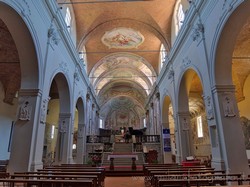|
Sesto Calende (Varese, Italy): Abbey of San Donato
|
|
|
Show an other place around Milan worth a visit: |
 The church described in this page is what remains of the Abbey of San Donato. The church described in this page is what remains of the Abbey of San Donato.
It is the main monument of Sesto Calende and another of the many Italian treasures of art and history that would deserve to be more known and visited.
The church was erected between the 9th and 10th centuries, near the abbey, which now doesn't exist any more.
Externally the church is not particularly remarkable. The façade, rather low, is devoid of any decoration, with the exception of a rest of a fresco inside a niche created between the arched frame of the original door and the rectangular frame of the current entrance door.
However, it has to be noted that the structure of the lower half of the façade consists of a beautiful alternation of blocks of grey light blue serizzo and blocks of white stone of Angera.
The remaining walls of the building, including those of the high square bell tower, are in stone and cobblestones.
It is also possible to note the presence of various walled windows, both in the church and in the bell tower.
Of particular architectural value outside are the north (left) lateral apse and the central apse, decorated with brick and stone arches. In all external and internal walls, elements of former Christian and pagan buildings on which the present temple was built were inserted, as re-use materials.
The most striking part of the church is however its interior, characterized by the presence of interesting elements and rich in frescoes and artworks of various ages.
The structure is that of a basilica, with three naves, a higher and larger central one and two lateral ones. The central presbytery is in a raised position and beneath it there is the large Romanesque crypt.
Very particular is the presence of a nartheus, anterior to the naves, a structure typical of the more ancient basilicas. Delimited by columns of Roman origin, it was originally open, and was later walled and covered to expand the church.
That it is a separate area compared to the naves it can be understood from the fact that the naves are partially interrupted by arches much lower than the ceiling. From the outside, the thing is even more evident, as it can be noticed, in front of the church's higher body, with a sloping roof on two levels, a low structure with a cover that does not connect with the rest.
The lateral apses are asymmetric. The left one (Fig. 2) has a semi-circular plant and presents the original Romanesque frescoes. There are God on the throne and various Saints.
The right apse (Fig. 3), with a rectangular plan, presents on the walls late-Renaissance frescoes of the second half of the sixteenth century. In particular, on the left there is a Last Supper, made by Tarillo da Curia in 1581. The cover is instead of the eighteenth century and was made when the original one was destroyed.
Of the eighteenth century are also the frescoes by Biagio Bellotti decorating the walls and the vault of the central apse. Looking carefully it is possible to notice that part of the previous frescoes is visible above the altar, with the lower end of a blessing Christ in Romanesque style still recognizable!
Other noteworthy frescoes are the precious Madonna of the Lemons (Fig. 4), of the late-Renaissance and transferred on canvas to be restored, and the Madonna of the Milk on the second pillar on the left.
On the right, just after the narthex, there is a chapel dedicated to Santa Caterina (Fig. 5), completely decorated with frescoes by Bernardino Zenale (1503) depicting episodes from the life of the saint. The author of the frescoes is the painter who, together with with Bernardino Butinone, frescoed with solemn Stories of Sant'Ambrogio the Grifi Chapel in the Church of St. Peter in Gessate in Milan.
The original Romanesque style is evidenced by the crypt (Fig. 7) formed by columns supporting the arches of the vaults. In them it is still possible to recognize, but not for a long time any more, sinopias of the Nativity and of the Ave Maria.
Last but not least, there is the valuable carved wooden choir with 15 places (Fig. 6) and an ancient renessaince wood crucifix by De Donati (Fig. 8).
Other pictures of the Abbey of San Donato in Sesto Calende and info about its history in the section Photography of this web site
Categories: Places of historical value of artistic value
Via Abbazia, 6, 21018 Sesto Calende VA |
Further pictures of Abbey of San Donato in the section Photography |